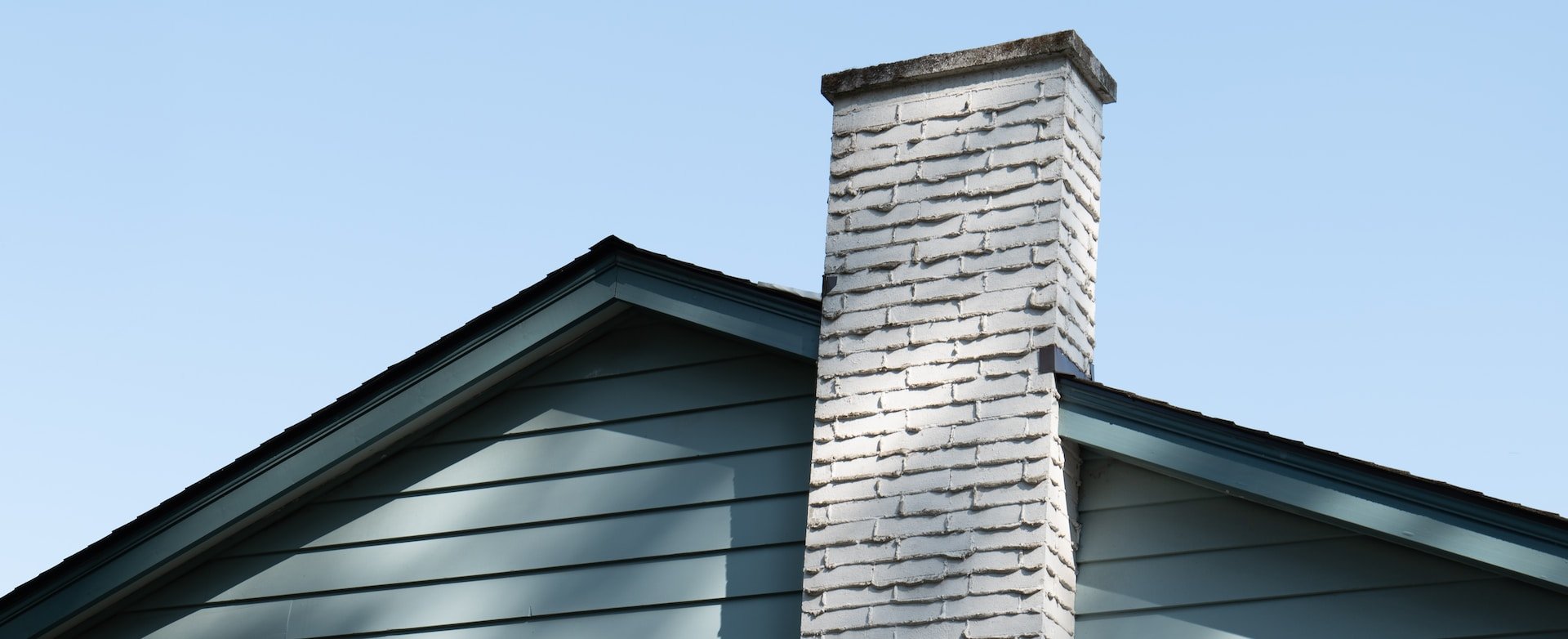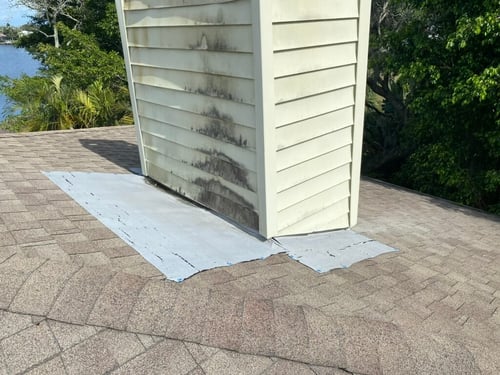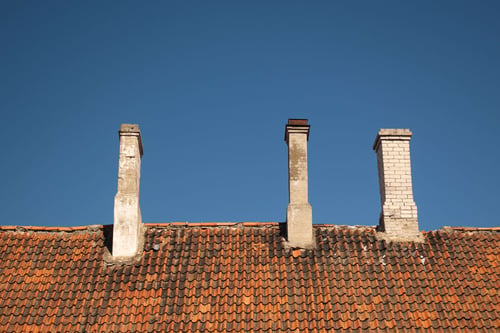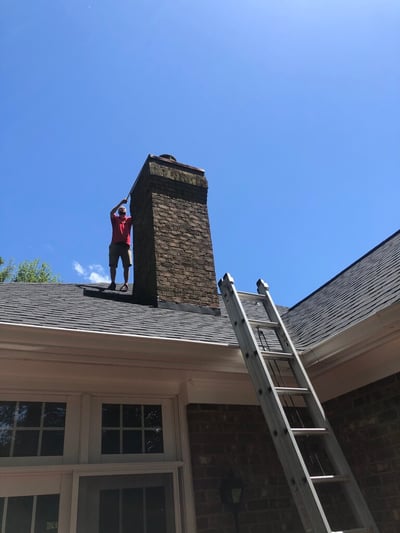What Is Chimney Flashing & Why Is It Important?
July , 2023 | 6 min. read

When it comes to maintaining a durable and watertight roof, one essential component that often goes unnoticed is chimney flashing. Chimney flashing serves as a crucial line of defense, preventing water intrusion and protecting against potential damage. Understanding what chimney flashing is and why it matters is key to appreciating its significance in maintaining the integrity of both the roof and the chimney. So, what is it?
Gee, I’m glad you asked! Otherwise, you’d just be reading the rest of the 1,250 words of an article of my choice, which could be about anything from why pink is my favorite color to the way I take my latte in the morning. Alright, in all seriousness, RoofCrafters gets asked this question quite a bit, and for good reason! Chimney flashing is an integral component of your roof, and without it, your home would suffer the consequences.
That being said, since you have chosen to read an article about chimney flashing and not what my favorite animal is and why, in just a few short moments you’ll be learning exactly what chimney flashing is and why it’s important, if every home is required to have it, and how the experts install it. So, without further ado, let’s get started!
What Is Chimney Flashing?
Chimney flashing is the material or construction technique used to create a watertight seal between the chimney and the roof. It is an essential component of a chimney system, designed to prevent water from entering the building through the junction of the chimney and the roof.
Flashing is typically made from metal, such as aluminum, copper, or stainless steel, due to its durability and resistance to corrosion. The flashing is installed around the base of the chimney where it meets the roof. It consists of several components:
- Base flashing: This is the bottom layer of flashing that sits on top of the roof surface and is usually embedded in a layer of roofing cement or underlayment.
- Step flashing: Step flashing consists of individual metal pieces that are layered up the sides of the chimney. Each piece is placed over the previous one, resembling a series of steps, hence the name. Step flashing ensures that water is directed away from the chimney and onto the roof.
- Counterflashing: Counterflashing is the top layer of flashing that is embedded into the chimney's mortar joints or is fastened to the chimney. It covers the step flashing and provides an additional barrier against water intrusion.

Installing chimney flashing helps to prevent water leaks and protects the chimney structure, roofing materials, and the interior of the building from water damage. Proper maintenance and inspection of chimney flashing are crucial to ensure its effectiveness over time. Chimney flashing is also important for several reasons:
Waterproofing: The primary purpose of chimney flashing is to create a watertight seal between the chimney and the roof. Without proper flashing, water can enter the building through gaps or cracks around the chimney, leading to water damage, rot, mold growth, and structural issues.
Protection of roofing materials: Flashing helps to divert water away from the vulnerable areas where the chimney intersects with the roof. It prevents water from seeping under the roofing materials, which can cause deterioration, including shingle damage, wood rot, and a weakened roof deck.
Preservation of chimney structure: Water infiltration can have a detrimental effect on the chimney itself. Over time, moisture can lead to the deterioration of mortar joints, rusting of metal components, and even the weakening of the chimney structure. Proper flashing ensures that water is directed away from the chimney, preserving its integrity and prolonging its lifespan.
Energy efficiency: In addition to preventing water leaks, chimney flashing also helps to maintain proper insulation and energy efficiency within the building. A well-sealed chimney reduces drafts and heat loss during colder months and prevents hot air infiltration in warmer seasons.
Cost savings: By preventing water damage and associated issues, proper chimney flashing can save homeowners from costly repairs and renovations. It is an investment in the long-term protection of the chimney, roof, and overall structural integrity of the building.
Chimney flashing plays a critical role in keeping the chimney and the surrounding roof area watertight, protecting against water damage, preserving the chimney structure, improving energy efficiency, and saving money in the long run.
Does Every Roof Require Chimney Flashing?
Chimney flashing is not required for every type of roof. Whether or not a roof requires chimney flashing depends on the specific construction and design of the roof, as well as the presence of a chimney. Chimney flashing is typically necessary when there is a chimney that extends through the roof. The flashing is needed to create a watertight seal between the chimney and the roof, preventing water from entering the building at that junction.

However, if a roof does not have a chimney or any other roof penetrations in the vicinity, then chimney flashing may not be required. In such cases, the roof can be constructed and sealed in a way that ensures proper waterproofing without the need for specific chimney flashing. It's important to consult with a roofing professional or contractor who can inspect your specific roof and chimney configuration to determine whether chimney flashing is necessary for your particular situation. They can provide expert advice on the appropriate waterproofing measures for your roof.
How Is Chimney Flashing Installed?
 Chimney flashing is typically installed in several steps to ensure a proper and watertight seal between the chimney and the roof. The first layer of flashing, known as the base flashing, is installed. It is a horizontal piece of metal that sits on top of the roof surface surrounding the chimney. The base flashing is usually embedded in a layer of roofing cement or underlayment. It is carefully positioned and secured to the roof to ensure it overlaps the edges of the chimney base and provides adequate coverage.
Chimney flashing is typically installed in several steps to ensure a proper and watertight seal between the chimney and the roof. The first layer of flashing, known as the base flashing, is installed. It is a horizontal piece of metal that sits on top of the roof surface surrounding the chimney. The base flashing is usually embedded in a layer of roofing cement or underlayment. It is carefully positioned and secured to the roof to ensure it overlaps the edges of the chimney base and provides adequate coverage.
Step flashing is installed along the sides of the chimney. It consists of individual metal pieces shaped like an "L" or a "Z". Each piece is layered vertically, with one end placed over the previous piece. The step flashing is positioned in a way that allows water to flow down and away from the chimney onto the roof surface. The top layer of flashing, which is called the counterflashing, is installed to cover and protect the step flashing.
It is typically a vertical piece of metal that is either embedded into the chimney's mortar joints or fastened to the chimney. The counterflashing overlaps the step flashing and creates a sealed barrier against water intrusion. Throughout the installation process, sealants such as roofing cement or silicone are applied to the joints and seams of the flashing to ensure a watertight seal. The flashing is also securely fastened to the roof and chimney using appropriate fasteners, such as nails or screws.
The Importance of Your Chimney Flashing
As you now know, chimney flashing plays a crucial role in maintaining the integrity of a building's roof and chimney system. It serves as a protective barrier, preventing water infiltration and potential damage. By creating a watertight seal between the chimney and the roof, flashing helps safeguard against leaks, water-related deterioration, and costly repairs.
Chimney flashing not only protects the roofing materials but also preserves the chimney structure itself, preventing moisture-related issues such as mortar deterioration and rusting of metal components. Additionally, proper flashing contributes to energy efficiency by reducing drafts and heat loss during colder months and preventing hot air infiltration in warmer seasons.
Whether it's traditional metal flashing or more advanced flashing systems, the importance of chimney flashing cannot be overstated. It provides peace of mind to homeowners, protecting their investment and ensuring a safe and comfortable living environment. To ensure proper installation, repair, and maintenance of your chimney flashing for optimal performance, be sure to hit the “schedule an inspection” button down below, and one of our roofing experts will meet with you to discuss your options at your earliest convenience.
My name is Cassie, and I’m the Content Manager here at RoofCrafters. I was born and raised in Chicago, Illinois, and made my way out to Florida post-college graduation. I’m incredibly passionate about writing and creating valuable content that helps others with the collaboration of my marketing team. When I’m not working, I enjoy shopping (a little too much), spending time at the beach, and reading!



